Helix and Leesa are two of the most popular online bedding brands in the game, and for good reason! Not only do these mattress companies both apply thoughtful designs to their products, but they also happen to sell a lot of different ones, from mattresses to bedding, pillows, and more. But that’s pretty much where the similarities end.
So, how do you figure out which of these bed-in-a-box mattresses is right for you? Well, I’m so glad you asked.
In this comparison, I’m going to size up the Helix Midnight mattress against the original all-foam Leesa. We’ll compare constructions, talk about their distinct feels, and talk about which sleepers might like them most.
Short on time? Skip down to my review summary.
Helix vs Leesa
Product
Firmness
Score
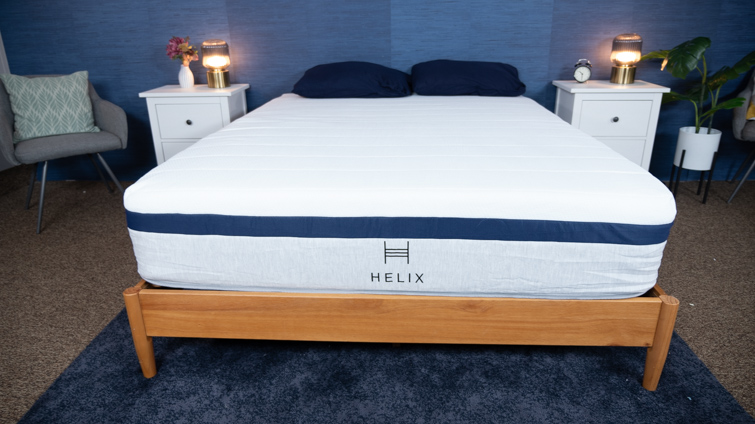
Product
Firmness
Score
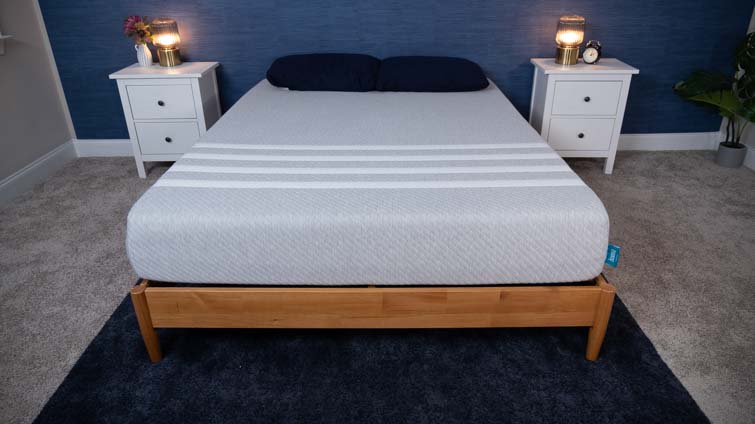
Product
Firmness
Score
Helix vs Leesa Mattress Overview
Here’s a brief overview of the strong points of the Helix and Leesa, as well as which type of sleepers are best suited for them.
| Helix is best for… | Leesa is best for… |
| Couples | Seniors |
| Back sleepers | Back sleepers |
| Side sleepers | Side sleepers |
Helix vs Leesa Video Review
Need a quick rundown of each mattress and who I recommend them for? Check out my Helix vs Leesa video review below.

Helix vs Leesa: Top Similarities
- Warranty: Both mattresses are backed by a 100-night sleep trial and 10-year warranty.
- Cooling: Both mattresses are designed with cooling features. The Helix has a breathable cover, while the Leesa has a breathable cover and layer of breathable foam.
- Responsiveness: I also found that both mattresses are fairly responsive. What I mean by this is that I didn’t have any trouble moving around and changing positions as I snoozed.
Helix vs Leesa: Top Differences
- Firmness: The Leesa is much softer than the Helix Midnight at 5.5 out of 10 on the firmness scale. For reference, the Helix Midnight scored a 6.5 out of 10, which is the industry standard for most beds.
- Motion Transfer: The Leesa performed better on our motion transfer test, meaning less movement travels from one side of the bed to the other.
- Construction: The Helix is a hybrid mattress that uses innerspring coils and foams, while the Leesa is an all-foam mattress.
Helix vs Leesa: Construction & Feel Differences
Now it’s time to focus on what these beds feel like. In the following sections, I’ll dig into the juicy details of both beds and discuss various factors like firmness, pressure relief, bounce, and sinkage.
Before we begin, I’d like to note that these factors are highly subjective and can vary significantly based on individual body size, shape, and weight.
What’s the Firmness Difference?
When it comes to mattresses, firmness isn’t a one-size-fits-all scenario. Your size, weight, shape, and other factors all determine your ideal level of firmness. So your preferences might not be the same as mine. When testing a mattress for firmness, we try to capture the variance different people might feel. I test every bed with colleagues of various body shapes, types, and sizes, then average those responses to determine the final firmness score.
My colleagues and I gave the Helix a 6.5 out of 10 on the firmness scale. We rate firmness on a scale of 1 to 10 with 1 being the softest and 10 being the firmest. For reference, the industry standard for a medium-firm mattress is a 6.5 on the firmness scale.


The Leesa is a much softer bed than the Helix, landing at 5.5 out of 10 on the firmness scale, below the industry standard.
What Does Each Mattress Feel Like?
The Helix is a hybrid mattress. Hybrid mattresses use a combination of memory foam and springs to balance comfort and durability. Since the Helix is a medium-firm hybrid mattress, most people should find it supportive and responsive. When testing the Helix, I felt supported by the individually wrapped coils in this bed’s support layer.
I also noticed that the Helix is very responsive. I found it very easy to move around on the Helix Midnight while testing it. This bed has plenty of bounce for sex and combination sleeping – both of which require a lot of moving around and changing positions.
However, a highly responsive mattress usually transfers more motion from one side of the bed to the other. While the Helix mattress had solid motion transfer results for a hybrid bed, you’re more likely to feel your partner moving on the other side of the mattress at night.
On the flip side, Leesa is an all-foam bed. It’s much softer than the Helix and has a doughy, cushiony feel. This makes the Leesa mattress great for side sleepers who need extra sinkage and pressure relief. Stomach sleepers, on the other hand, might find this bed a bit too soft for their liking.
How Does The Construction Differ?
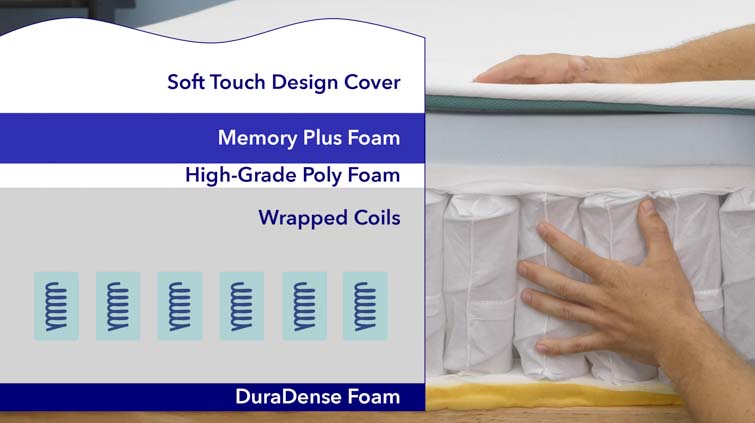
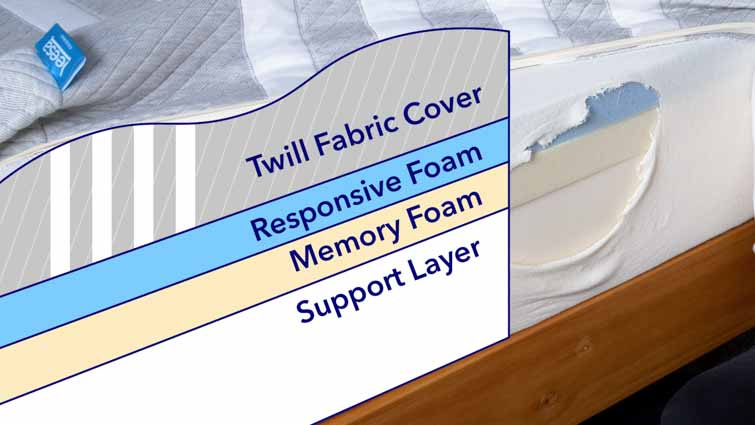
Helix vs Leesa Per Body Type
Every bed will feel different to sleepers depending on individual attributes and preferences, such as body weight and sleeping position. In this section, I’ll compare how the Helix and Leesa mattresses perform for various sleepers.
Helix Midnight Body Weight Scale
| Body Weight | Side | Back | Stomach |
|---|---|---|---|
| Light (under 130 lbs) |
good | excellent | good |
| Average (130-230 lbs) |
excellent | excellent | good |
| Heavy (over 230 lbs) |
good | good | good |
| Body Weight: Light (under 130 lbs) | |
|---|---|
| Side Sleeper | good |
| Back Sleeper | excellent |
| Stomach Sleeper | good |
| Body Weight: Average (130-230 lbs) | |
| Side Sleeper | excellent |
| Back Sleeper | excellent |
| Stomach Sleeper | good |
| Body Weight: Heavy (over 230 lbs) | |
| Side Sleeper | good |
| Back Sleeper | good |
| Stomach Sleeper | good |
Leesa Original Body Weight Scale
| Body Weight | Side | Back | Stomach |
|---|---|---|---|
| Light (under 130 lbs) |
good | excellent | good |
| Average (130-230 lbs) |
good | excellent | unpleasant |
| Heavy (over 230 lbs) |
unpleasant | unpleasant | unpleasant |
| Body Weight: Light (under 130 lbs) | |
|---|---|
| Side Sleeper | good |
| Back Sleeper | excellent |
| Stomach Sleeper | good |
| Body Weight: Average (130-230 lbs) | |
| Side Sleeper | good |
| Back Sleeper | excellent |
| Stomach Sleeper | unpleasant |
| Body Weight: Heavy (over 230 lbs) | |
| Side Sleeper | unpleasant |
| Back Sleeper | unpleasant |
| Stomach Sleeper | unpleasant |
Helix vs Leesa Comparing Mattress Performance
Temperature
Many factors impact a mattress’s cooling ability, but construction is usually front and center. Hybrid mattresses are typically better at cooling because they have plenty of room for air to flow through them. In contrast, memory foam beds tend to trap heat and get hotter overnight.
After resting on each mattress for a few minutes and measuring how much heat each one trapped, I found that the Helix performed a little bit better overall, likely due to its hybrid construction.
However, I thought the Leesa performed despite being a memory foam bed. While it is a memory foam bed, I think its materials are very breathable, which helps it stay cool. The Leesa Original’s comfort layer also features breathable foam to promote airflow and help mitigate some of the heat-trapping tendencies you tend to see in other memory foam mattresses.
Motion Isolation
Motion Isolation refers to the amount of movement that is felt through the mattress when your partner, kids or pets move around. In my experience, I’ve found that hybrid beds usually have a lot of bounce, and the Helix is no exception. The Helix is super responsive, meaning it’s easy to switch between different positions and get in and out of bed. The only negative is that couples with restless sleepers will likely feel all of their partner’s movements.
The Leesa Original has the opposite problem. When testing the motion isolation on this mattress with a colleague, I couldn’t feel anything they were doing on their side of the bed. Motion isolation is fantastic if you have a restless partner or pet, but it could make switching between sleeping positions and having sex difficult.
To ensure I’m being as objective as possible, I perform a few tests to determine if a bed is good at isolating motion. One of those tests consists of dropping a steel ball from various heights and measuring the disturbance it causes using a seismometer.

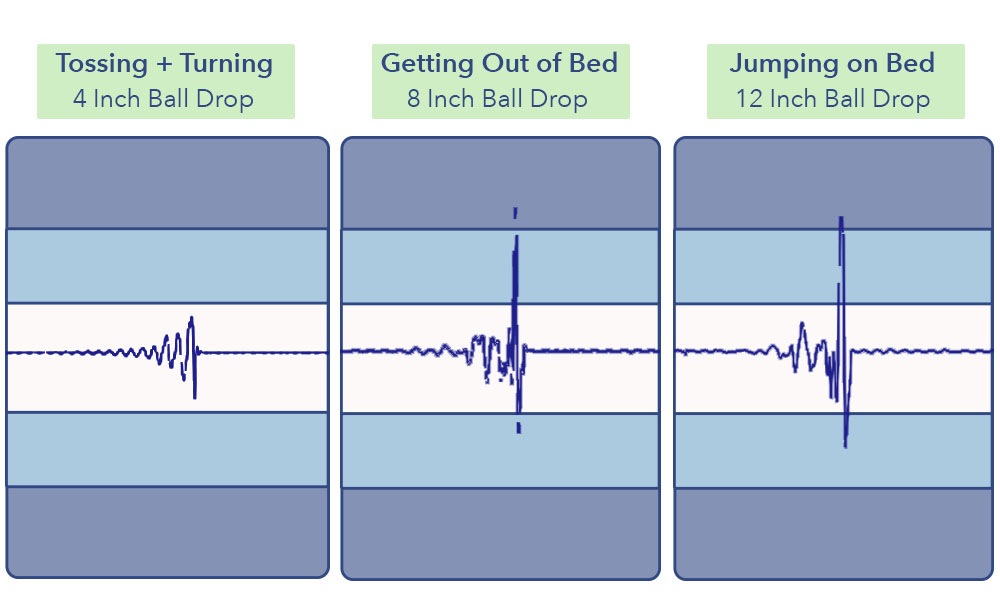
During this test, I found that the Helix Classic transfers more motion to the other side of the bed, while the Leesa absorbs and isolates nearly all the movement to the impact site. In other words, you probably won’t feel your partner tossing and turning on the Leesa mattress.
Edge Support
When testing the edge support on both mattresses, I didn’t find much sinkage as I sat on the edges and corners of the Helix, likely due to its individually wrapped coils. However, the Leesa was another story. Since the Leesa is on the softer side of all-foam beds, I noticed a good amount of sinkage as I sat on its edges and corners, which is typical of an all-foam bed. Because of this, I wouldn’t recommend the Leesa to sleepers with mobility issues that may need extra help getting in and out of bed.
Pressure Relief
The Helix did a great job on our pressure map test. During this test, we use a specialized mat to measure how much pressure the materials put on different body parts. The mat then creates a graphic or “map” of the body using color-coded imagery.
Areas with low pressure buildup are blue and green, and areas with high pressure buildup are yellow and red. As you can see on the map below, there is a lot of blue and green, indicating that this bed is good at relieving pressure.
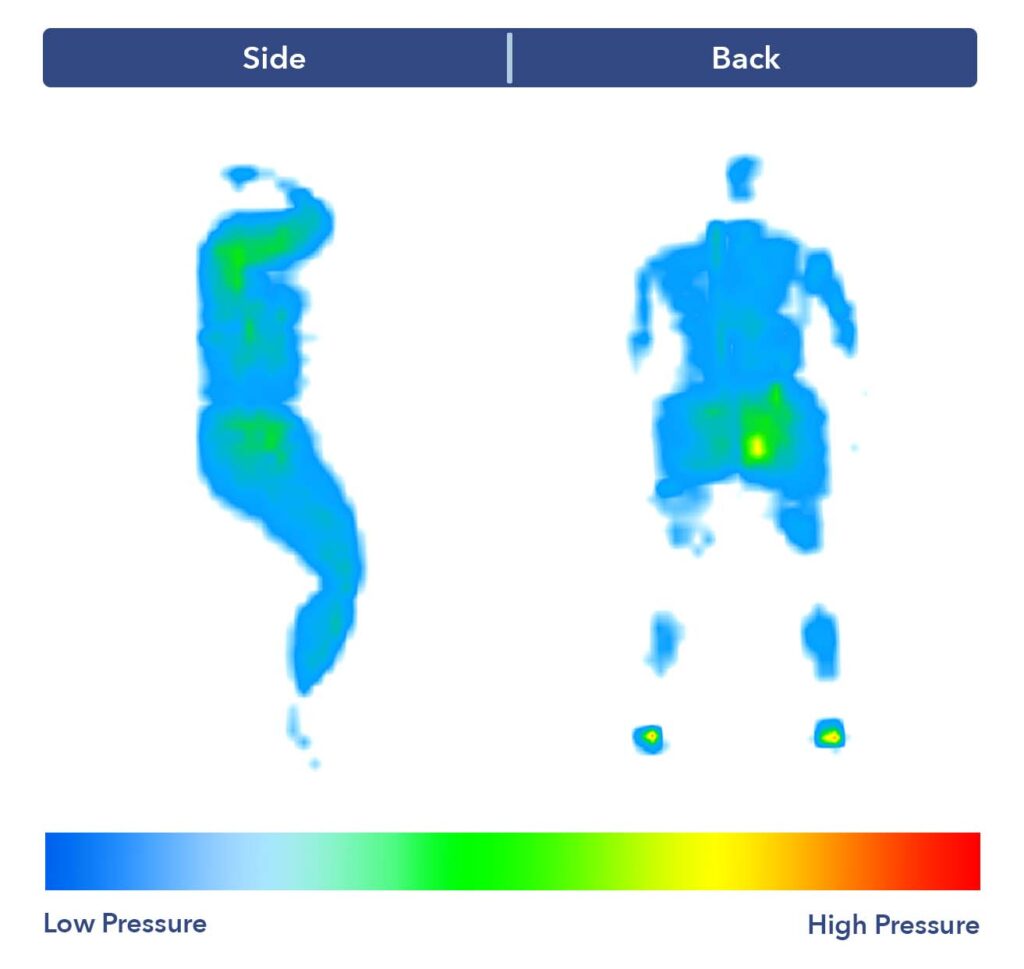
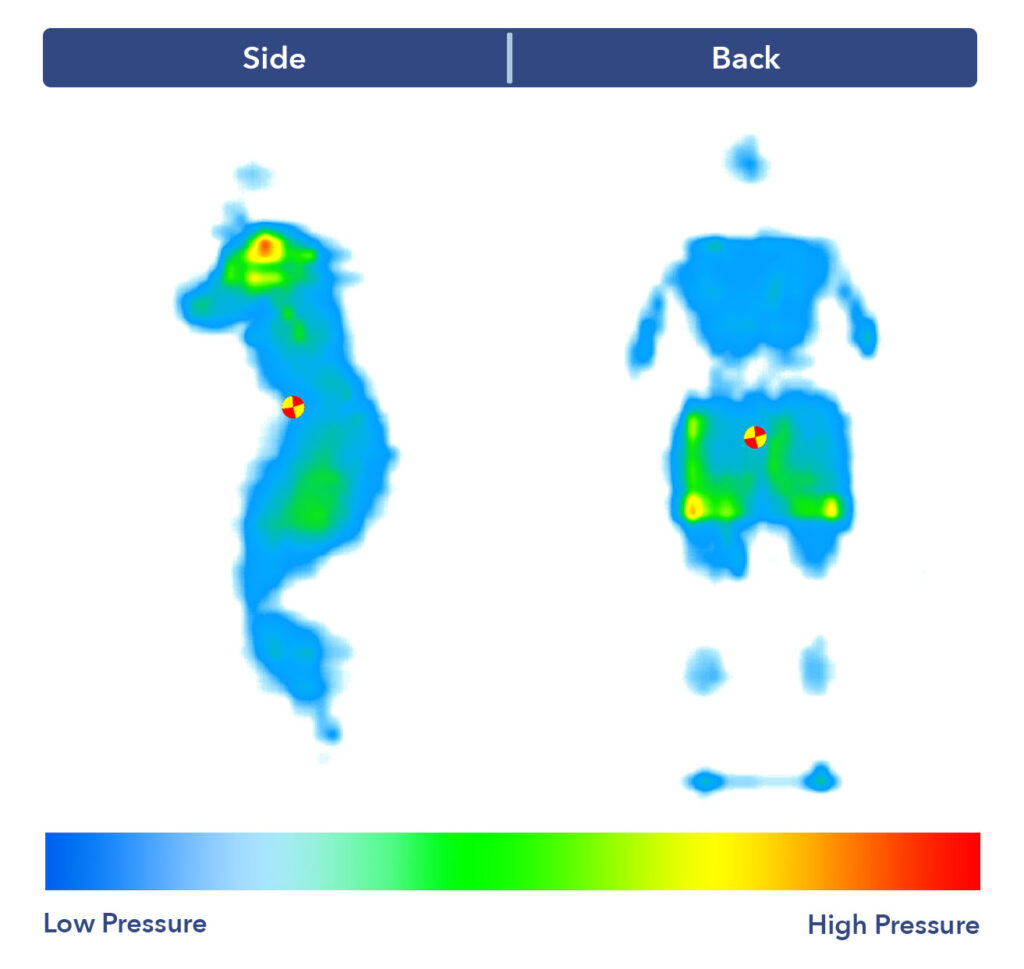
There is also a good amount of green and blue on the pressure map on the right, meaning the Leesa had good test results as well. However, you can see more yellow spots, indicating pressure buildup, which means the Leesa might not be the best bed for sleepers with sensitive shoulders.
Pain Relief
The results of the pressure relief test can indicate whether these mattresses aid in reducing pain in specific areas. I think the Helix and Leesa are good options for most back sleepers. However, side sleepers, especially those with shoulder pain, should go with the Helix or one of our best mattresses for side sleepers.
Durability
Typically, memory foam beds wear down quicker than hybrid mattresses. For that reason, I would say the Helix Midnight is more durable than the Leesa. The Helix is firmer and has better edge support, meaning it’s less likely to sag prematurely. The Helix also has a support layer that contains pocketed coils, which should add to that durability.
Company Policies
Helix Policies
- Trial Period – 100-night trial
- Shipping – Free shipping
- Mattress Warranty – 10-year warranty
Leesa Policies
- Trial Period – 100-night trial
- Shipping – Free shipping
- Mattress Warranty – 10-year warranty
Helix Customer Service Rating
- Good: I gave Helix this rating because I was able to immediately connect with a human using the chat function on the Helix site. I asked “Which Helix is best for side sleepers” and got a pretty vague answer that all of their mattresses are designed for side sleepers, but once I asked for something soft (which is best for side sleepers) I was able to get some good specific recommendations.
Leesa Customer Service Rating
- Satisfactory: I gave Leesa a satisfactory score because they didn’t have someone manning their chat feature when I reached out (it was an automatic response with suggested answers), but I was able to get through to an agent when I called their help number.
Comparing Helix vs Leesa Price
When deciding between the Helix and Leesa mattresses, your decision may come down to price. Let’s take a peek at how much these beds cost in our pricing chart. Keep in mind that you can always visit our Helix mattress coupon page for a nice discount.
Prices listed will be before discount or offer for each size.
| Size | Leesa | Helix Midnight |
|---|---|---|
| Twin | $799 | $699 |
| Twin XL | $849 | $799 |
| Full | $999 | $949 |
| Queen | $1,099 | $1,099 |
| King | $1,299 | $1,449 |
| California King | $1,299 | $1,449 |
Other Helix and Leesa Mattress Comparisons
Wondering how the Helix and Leesa stack up to some of their competitors from other online mattress companies? Take a look at some of our other comparisons below.
Helix
- Helix vs Helix Luxe
- Helix vs Purple
- Helix vs Tuft & Needle
- Helix vs Casper
- Helix vs GhostBed
- Helix vs Saatva
Leesa
- Casper vs Leesa
- Leesa vs Purple
- Leesa vs Tempurpedic
- Leesa vs Nectar
- Leesa vs Tuft & Needle
- Casper vs Leesa vs Tuft & Needle vs Saatva
Comparing Other Mattress Models
Helix vs Leesa Frequently Asked Questions
How do the Helix and Leesa mattresses ship?
Helix and Leesa both offer free shipping on all their mattresses.
What are the return policies for the Helix and Leesa mattresses?
Both companies offer a 100-night sleep trial. If you don’t like your mattress within this period, you can return it for a full refund (minus some shipping costs).
Is the Helix softer than the Leesa mattress?
No, the Helix is not softer than the Leesa. We gave the Helix rating of 6.5 out of 10, with 1 being the softest and 10 being the firmest. Using the same scale, we rated the Leesa a 5.5 out of 10.
Are the Helix and Leesa mattresses good for hot sleepers?
Since the Helix uses a hybrid design with pocketed coils, it should do a decent job of keeping you cool through the night. The Leesa Original is a pure memory foam mattress, meaning it will likely trap too much heat. Neither bed has exclusive cooling features, so I would suggest that extra hot sleepers check out one of our best cooling mattresses.
Before we wrap up this comparison, I’d like to highlight what I like most about the Helix and point out some of my complaints.
As we finish this comparison, I’ll leave you with what I thought the Lessa did right and some areas where it missed the mark.
Our Review Process
Our Sleepopolis reviewers personally test each mattress. We start by unboxing the mattress to figure out how difficult (or easy) it is to get the mattress from the box to the bed. Then, we spend time laying on the bed in different positions, taking time to assess it on our backs, stomachs, and sides. Next, we perform our Sleepopolis tests, using specialized tools to measure qualities like motion transfer, bounce, and pressure relief. Our last step is to open up the mattress and take a look at each layer. These steps allow us to give our final verdict on the mattress.


























